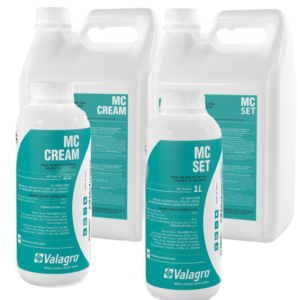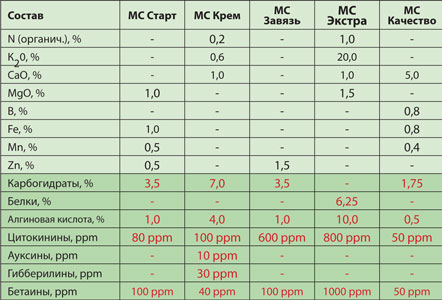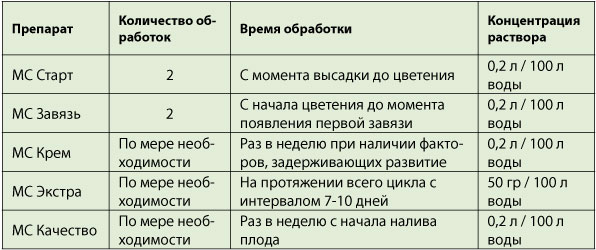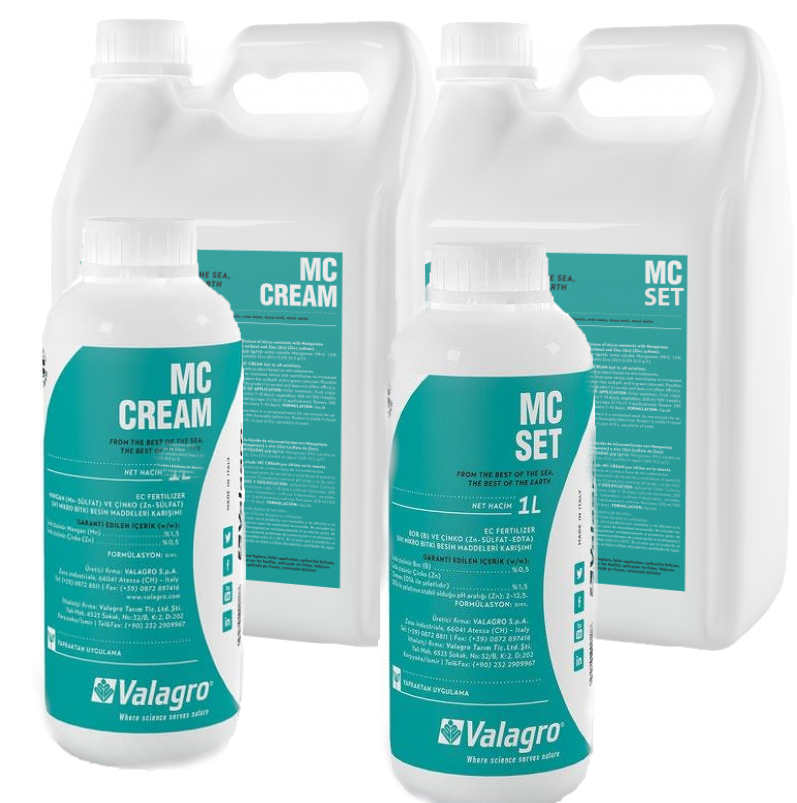
Phytohormones and microelements for each critical phase of plant development
All plants produce their own growth regulators, such as cytokinin, gibberellin, auxin, etc. However, in the stress conditions (drought, heat, wind, frost, phytotoxicity), the production of its own hormones is greatly reduced. This leads to weakening of the plant, making it more sensitive to the effects of diseases and pests. Stimulants MAXIKROP effective due to the high concentration of these hormones listed. The most concentrated plant source of growth regulators is seaweed Fucus bubbly (Ascophyllum nodosum).
Consider, for starters, the functions of the main ingredients of MAXYCROP stimulants.
Cytokinins. The process of cell division in biology is called cytokinesis, hence the name of this group of compounds is cytokinins. Currently, cytokinins are found in microorganisms, algae, ferns, mosses and in many higher plants. However, their content in the tissues of most plants is very small. The ideal source of cytokinins is Fucus bladder, chosen as a raw material base by the company Valagro in the production of its stimulants.
The highest concentration of cytokinins in developing seeds and fruits of plants, and precisely in those places where there is an active division of cells. In the seeds of succulent fruits, the content of cytokinins is higher than in the flesh. More or less significant amounts of cytokinins are also found in meristematic tissues. There is a clear relationship between the growth rate and the content of cytokinin in the organs. For example, in resting bulbs the content of cytokinins is very low, but it increases significantly by the time of germination.
The center of synthesis of cytokinins in plants is considered the meristem of root tips. These substances were found in the sow (xylem juice of plants), which suggested the possibility of moving cytokinins along the vessels of xylem to growing parts of plants: developing kidneys, seeds, fruits, internodes and young leaves. Currently, a large number of compounds with cytokinin activity have been synthesized. Basically, these are adenine derivatives.
Cytokinins are involved in the regulation of physiological processes in higher plants, and, like other phytohormones, they have a multifunctionality of action. However, the most typical effect of the use of cytokinins is stimulation of cell division. It is interesting that this process is not induced by a single cytokinin or auxin: only a certain combination of these hormones leads to active cell division.
Cytokinins also affect the laying and development of generative organs. When these hormones are treated, the flowering of many plants is accelerated, and in these processes, cytokinins act together with gibberellins. An important role played by cytokinins in the formation of sex in the flower. They contribute to the laying of female flowers in cucumber, spinach, corn, hemp.
These substances contribute to the interruption of the dormancy of the sleeping buds of tree cultures, tubers, seeds of certain plants. It is on this property that the use of cytokinins is based to enhance the germination of long-stored seeds.
Cytokinins participate in the regulation of the metabolism of organs that have already completed growth. Kinetin, for example, delays the processes of aging and decay.
Adverse factors of the environment – drought, flooding, low temperatures, salinization – sharply slow down the flow of cytokinins with the herring to the above-ground organs. As a result, in-flight slows growth, leaves quickly age. Treatment of plants in a stressful environment, preparations containing cytokinins, significantly improves their condition, and in case of flooding – completely eliminates adverse effects.
Cytokinins can be used to obtain more bushy plant forms, to inhibit aging, to increase the resistance of plants to unfavorable environmental factors, to shift the expression of sex to the female side.
One of the intriguing properties of cytokinins is their ability to slow the normal aging process of the leaves.If the leaf is separated from the plant (without rooting), it usually very soon ages, which is manifested in yellowing and in the loss of protein. However, if you apply a drop of cytokinin to such a sheet, it will have a green island of active tissue surrounded on all sides by yellowness.
Auxins: In the 20s – 30s of our century, the presence in plants of growth hormones: indolyl-tri-acetic acid (IUK) and its derivatives was established. They have received the general name “auxins”. IAA is also often called heteroauxin. So, auxins were discovered in the study of plant growth, but their functions are much broader. They are participants in the processes of division, growth, differentiation of cells. And, especially actively affect the root formation.
The transplantation of woody and shrubby species presents considerable stress for plants. This is due to the fact that a significant part of the roots during the excavation of the seedlings breaks down, especially their sucking endings. Plant survival in a new location depends on the speed of recovery of the root system. Removal of a stressful situation is possible against the background of the use of growth regulators, in particular, drugs containing Auctions. The survival rate at the new site of the treated trees is much higher.
Auxins are used to stimulate fruit formation and produce seedless fruits. Most often, growth regulators are used for this purpose when growing tomatoes, cucumbers, eggplants, peppers and some other crops in greenhouses, but it is also possible to use this method in open ground conditions, especially under unfavorable weather conditions.
Many garden plants (especially in apple and pear) begin premature fall of fruit. Padalitsa is poorly stored, has a non-commodity appearance. Sometimes, for this reason, most of the crop is lost. Treatment of the crown with auxins during this period significantly reduces losses. The effect of the drug is maintained for 2 weeks from the day of treatment. Plant treatment with growth regulators MAXYCROP also weakens the negative effect of frost on the maturing crop. In most of our country, late spring frosts occur periodically, which causes extensive damage to the gardens. In order to prevent damage to flowering trees, frosts are resorted to by smoking, local heating is used. But these methods of struggle are far from always effective. Phytohormones can come to help in such situations. Sprinkling of Valagro with autumn preparations during the period of the growth of shoots and the beginning of the laying of fruit buds delay the onset of the flowering period in the spring of next year for apple and pear trees for 5-7 days, apricots and peaches for 10 days. In addition, this method accelerates the ripening of the fruit for several days per year of treatment.
Gibberellin. At present, about 60 different gibberellins have been discovered, for which the abbreviation HA is used, gibberellic acid itself is designated HA3 according to this nomenclature. Organs and plant tissues contain from two to several compounds of Gibberellin nature. The content, shape, condition of gibberellin in the process of plant growth and development do not remain constant. Accumulation of GA in plants is promoted by illumination: during the day, during the day, their content in the organs of plants increases, and at night – decreases. In general, the content of GA in plant tissues varies from 0.01 to 1.4 mg per kg of wet weight. The highest content of GA in immature seeds.
GA can significantly affect the length of the stem. In this case, they can stimulate both cell division and their stretching. At the same time, gibberellins do not affect root growth, but in high concentrations in aquatic culture even worsen the condition of the roots. Also GA activates the growth of fruits.
Gibberellins play an essential role in the phase of the transition of plants to flowering. In plants “long day” in an unfavorable period of illumination, stem extension and flowering are stimulated by treatment with gibberellin-containing preparations. However, in plants of the “short day” and in “long-day” plants with leaf stalk treatment of GA is ineffective.In some plant species, gibberellins exert an influence on the expression of the sex: the treatment of plant GA promotes male sexualization.
Gibberellins also activate the germination of seeds of many plant species. It is known that the sleeping buds and seeds of a number of species are removed from the state of rest by the action of low temperatures. The temperature factor in these cases can be replaced by treatment with gibberellins. For the germination of photosensitive seeds, the action of light is necessary. It can also be replaced by GA. In particular, gibberellin is used to treat dormant potato tubers in order to accelerate germination. Studies have shown that during germination the concentration of gibberellins in tubers rises 20-30 times.
Gibberellin can delay the aging of leaves and fruits. For example, gibberellins, applied separately (in an unbalanced form with other phytohormones), delay reddening of tomatoes.
The action of gibberellins is associated with many physiological reactions in the body of the plant. First, it has been established that GAs affect auxin metabolism: they participate in transport of IAA (indolylacetic acid), possess auxin-preserving effect, enhance biosynthesis of IAA, promote release of IAA from bound forms. In addition, GA activates the biosynthesis of nucleic acids and proteins, the action of a number of enzymes (hydrolase, oxidoreductase), carbohydrate metabolism. As a result, GAs affect the operation of the chromosome apparatus.
Preparations containing gibberellic acid (GA3) are used to increase the yield of kishmish (seedless) varieties of grapes, characterized by comparatively small berries. Spraying of the grapevine with the MAXIKROP stimulator The cream (2.5 l / ha) after 5-7 days after the end of flowering together with the BENEFIT preparation (2.5-3 l / ha) promotes the increase in the size of the berries one and a half to two and a half times and the increase in the level -Availability of 50-100%. Also, for a few days the ripening of the grapes is accelerated. Positively MAXIKROP acts on some seed varieties of grapes: the number of berries increases, maleness and seedlessness increase, the brush is loosened (which reduces the berate’s vulnerability by phytopathogens), and maturation is accelerated.
In order to increase the yield, MAXYCROP series preparations are also used for the treatment of strawberries.
Alginic acid. The acid is a polysaccharide extracted from brown algae and is a natural chelating agent. The presence of alginates in the MAXIKROP stimulant increases the resistance of the treated plants to viral infections.
Betaine. One of the functions of betaine is an increase in the permeability of cell membranes to water, the activation of the process of photosynthesis, and help in overcoming the stresses of plants from the effects of toxins.
At the same time, hormones are a very powerful weapon in the hands of the plant breeder, and overdose, as well as exposure to them outside the system, will lead to disastrous results – the plant will stop growing or die. That’s why the MAXIKROP line represents a balanced set of growth hormones and is by no means the maximum concentration.


MS Start is used to resume vegetative growth and other growth processes after a stressful period. The drug is a mixture of phytoindredients in active form, enriched with microelements (magnesium, iron, manganese and zinc) to prevent chlorosis and to create the most favorable conditions for the renewal of the growth cycle.
MS Ovary is created on the basis of highly effective phytohormones and includes: cytokinin, betaine, alginic acid, amino acids. The stimulator is enriched with zinc in chelate form and boron, which essentially stimulates the plant during flowering and ovary formation.
MS Extra is released in the form of microparticles in the form of flakes and has an ideal solubility. The preparation contains phytoindredients in active form and includes: be-taines, cytokinins, alginic acid, carbohydrates, 1-3-beta-glucan proteins. These components, derived from higher plants and seaweed, are processed and arranged in such a way as to ensure maximum productivity in both qualitative and quantitative parameters. In addition, the drug activates its own protective functions of the plant, increasing the immune barrier.
MC Cream stimulator based on phytohormones, made in the form of a suspension. Has a green color, is characterized by low pH, excellent recovery efficiency after stress and increased photosynthetic activity.
APPLICATION


